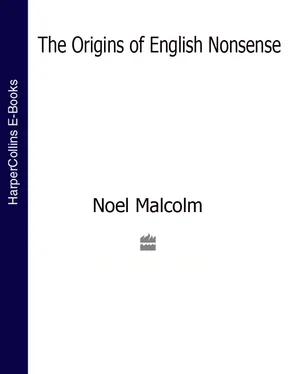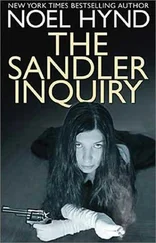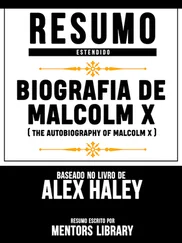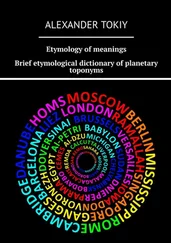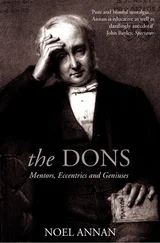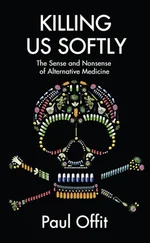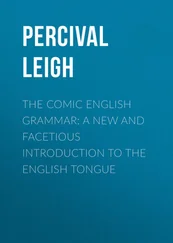Life scummes the Cream of Beauty with Times Spoon ,
And drawes the Claret Wine of Blushes soon.
There boiles it in a Skillet cleane of Youth ,
Then thicks it well with crumbl’d Bread of Truth …
‘I must intreat my Noble Reader ’, the Marchioness explained, ‘to read this part of my Book very slow, and to observe very strictly every word they read, because in most of these Poems , every word is a Fancy ’. 46The comic fragmentation of sense could hardly go any further than that.
CHAPTER 3
A short history of nonsense poetry in medieval and Renaissance Europe
LITERARY NONSENSE POETRY was virtually unknown to readers of English when Hoskyns wrote his lines in praise of Coryate in 1611. But although this kind of nonsense poem was absent (so far as we know) from classical literature, various literary genres of nonsense or near-nonsense had existed in Germany, France, Italy and Spain in the medieval and Renaissance periods. Some of these forms (above all, the vigorous and elaborate Italian nonsense poetry of the fifteenth and sixteenth centuries) are so close to the kind of poem Hoskyns introduced that it is hard to believe that he had no knowledge of them.
A full history of early European nonsense has never been written; many of the details remain very obscure. The general pattern which emerges from this material, however, is one of a complex and overlapping succession of styles and genres, undergoing the kind of development – through the ordinary mechanisms of individual invention, transmission to later poets, influence on (and from) neighbouring genres, and so on – which other literary forms also experienced. Nonsense poetry was, in other words, a typically or even a quintessentially literary phenomenon. It was not something dwelling, like dreams or madness, in the collective unconscious of Europe, liable to break out here, there or everywhere through its own spontaneous energies. On the contrary, it was something invented, learned and transmitted; something which existed only in a literary culture; and indeed something which, because of its essentially parodic nature, had a peculiarly intimate connection with the literary world – as intimate as that between a parasite and its host.
The earliest known nonsense poetry was written by a German Minnesinger, ‘Reinmar der alte’, who died in 1210. Just a few lines of unmistakable nonsense survive in his oeuvre, forming the first stanza of a three-stanza poem. They list a series of bizarre reversals of the natural order, using the traditional poetic-rhetorical device of ‘impossibilia’ (discussed more fully below, pp. 78–88).
Blatte und krone wellent muot willik sin,
so waenent topfknaben wislichen tuon,
So jaget unbilde mit hasen eber swin,
so ervliuget einen valken ein unmehtik huon,
Wirt dan[ne] der wagen vür diu rinder gende,
treit dan[ne] der sak den esel zuo der müln,
wirt danne ein eltiu gurre z’einem vüln:
so siht man’z in der Werlte twerhes stende. 1
Breastplate and crown want to be volunteer soldiers,
Boys playing with a top think they are acting wisely,
The boar hunts with hares, setting a poor example,
A feeble hen flies up and catches a falcon.
Then the cart goes in front of the oxen,
The sack drags the donkey to the mill,
An old nag turns into a filly:
This is what one sees in the world turned upside-down.
Since the rest of the poem is a love poem, the overall purpose of this initial stanza is clear: it is to set out a vision of a world in which the miraculous becomes the norm, in order then to describe the miracle of requited love. In the overall context of the poem, therefore, the first stanza is not free-standing nonsense but merely an extended rhetorical device. It even concludes by stating explicitly that it refers to that inversion of reality, the world turned upside-down, and any work which makes such a statement is confirming that it knows which way up the world really is. Nevertheless, the sheer bizarrerie and extended invention of this stanza make it possible for it to be read as if it were a piece of nonsense with no larger sense-making rhetorical purpose; and that indeed seems to be the way in which its influence was felt.
Several poets wrote similar pieces during the thirteenth century, establishing a kind of genre with its own stock forms and conventions. A typical piece is the following, by Reinmar von Zweter:
Ich kwam geriten in ein lant,
uf einer gense, da ich affen, toren vant,
ein kra mit einem habche die viengen vil der swine in einer bach;
Ein hase zwene winde zoch,
der jagte einen valken, den vienk er in den lüften hoch;
schachzabel spilten mukken zwo, meisen einen turn ich muren sach;
Da saz ein hirz unt span vil kleine sien;
da huote ein wolf der lember in den widen;
ein krebze vlouck mit einer tuben
ze wette, ein pfunt er ir ab gewan;
drie groze risen erbeiz ein han:
(unt) ist daz war, so naet ein esel huben. 2
I came riding on a goose
Into a land where I found apes and fools;
A crow and a hawk seized many pigs in a stream;
A hare who turned two windlasses
Hunted a falcon, which he caught high in the air;
I saw two flies playing chess, and titmice building a tower;
A stag sat there spinning many small silk threads;
The lamb kept watch over a wolf in the meadow;
A crab flew with a dove,
It made a bet with her, and won a pound;
Three big giants bit a hen to death;
And if that is true, then a donkey can stitch bonnets.
As this example shows, the overall pretext of the poem was usually that it was an eye-witness narrative, a tall story related by the poet: in this way the nonsense genre was able to stand more freely in its own right as a display of the poet’s own inventiveness, no longer limited by the function of a mere rhetorical device in a love poem. This medieval German genre is therefore known as ‘Lügendichtung’, or lie-poetry. 3
The general idea of a fibber’s or boaster’s narrative was not new, of course, either in literature or in folklore. One example of a lying tale comes in a Latin poem written in Germany in the tenth or eleventh century, the ‘Modus florum’: it describes how a king offered the hand of his daughter to whoever could tell the best lie, and presents the lying story of the man who won – a story which involves killing a hare, cutting it open and finding inside it huge quantities of honey and a royal charter. 4This is bizarre, but it is not a nonsense poem; although scholars have traditionally identified this Latin poem as the origin of the ‘Lügendichtung’ genre, its relationship to the medieval German poems is remote and quite tangential. 5
The general idea of the tall story may have been absorbed by the Lügendichtung as, so to speak, its form, but its content came from adapting a range of other stock literary devices. These included, most obviously, several types of impossibilia: the reversal of roles by animals (hens seizing hawks), the animation – or, to be more precise, the animal-ization – of inanimate objects (flying millstones being particularly common), and the performance by animals of complex human activities (such as spinning or building). 6Two other ways in which animals were treated in these poems seem to have reflected particular literary influences. First, the common imagery of animals playing musical instruments suggests a connection with the form of ecclesiastical-satirical writing in which church music and other functions were performed by animals. 7And secondly, the increasingly frequent references to contests and battles between different animals (and/or inanimate objects) reflects the influence of a mock-heroic or burlesque tradition which stemmed from the pseudo-Homeric Batrachomyomachia , the battle of the frogs and the mice. Given the huge popularity of the Roman de Renart , which itself depended on the device of using animals as humorous substitutes for the heroes of epic or romance, it is not surprising that this particular literary-parodic function – the function of burlesque – should have grown in importance in these German nonsense poems. And at the same time more indirect or glancing parodic relationships may have been at work with several of the other forms of beast poetry which were so popular in the Middle Ages, including the most fundamental of them all, the fable. 8
Читать дальше
